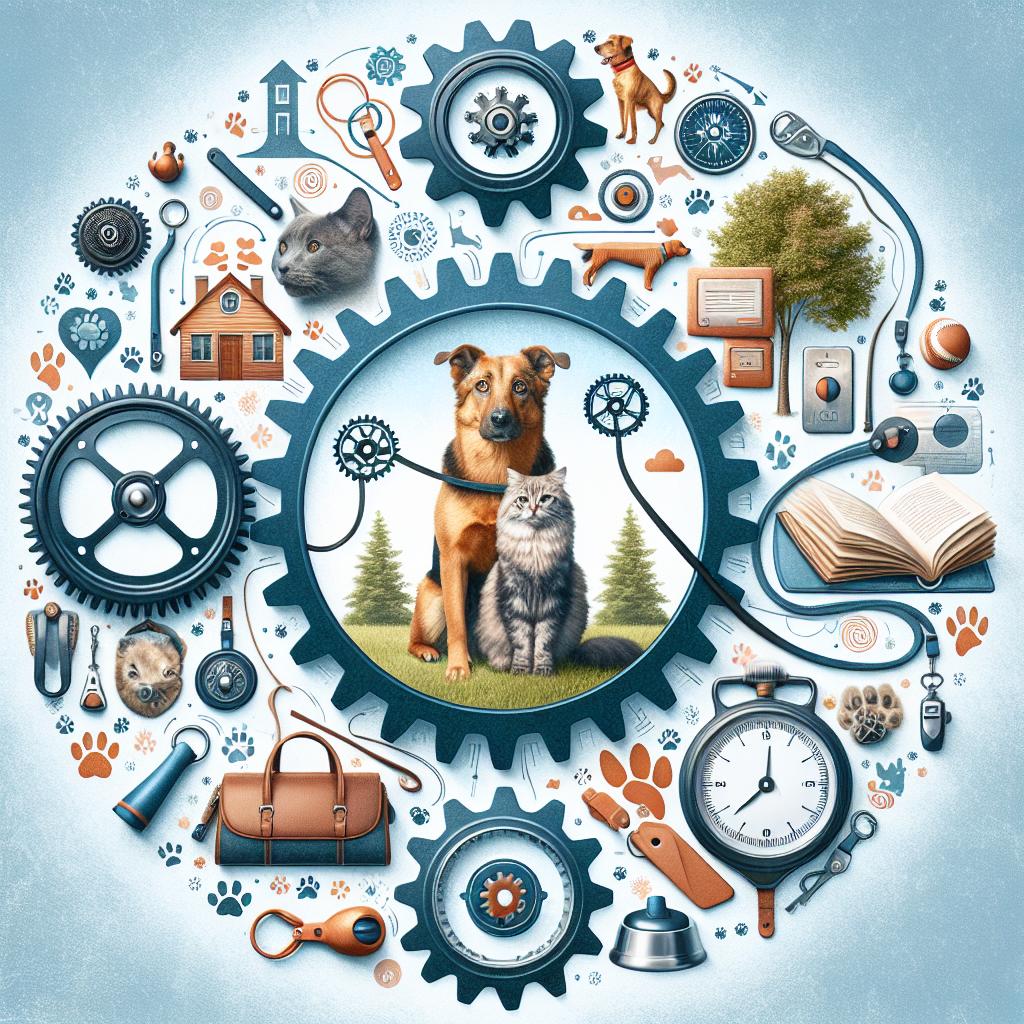Title: Taming the Chase: A Guide to Stopping Your Dog from Chasing Cats
Introduction:
Imagine a sunny afternoon in the park, where the sun casts gentle rays through the trees, and the promise of adventure hangs in the air. Suddenly, chaos ensues as your dog spots a feline friend and takes off like a lightning bolt, leaving you in a whirlwind of panic. The age-old rivalry between dogs and cats is a familiar tale, one often played out in backyards and city streets alike. While this instinctive behavior might seem natural, it can cause stress not only for you but also for the unsuspecting cat in the line of sight.
In this article, we will explore effective strategies to help you train your dog to curb their urge to chase cats, fostering a more harmonious relationship between your canine companion and the feline world. Whether you’re navigating the challenges of living with both pets or simply want to ensure peaceful interactions in your neighborhood, these insights will equip you with the tools needed to turn the chase into a calm coexistence. Join us as we embark on this journey towards tranquility, one paw at a time.
Understanding the Instincts Behind the Chase
Understanding why dogs chase after cats often comes down to their fundamental instincts. Many dogs are naturally driven by a strong prey drive, an instinct that compels them to pursue anything that moves quickly. This behavior is deeply rooted in their evolutionary history as hunters, where the chase represented both survival and a means to procure food. However, while the instinct to chase is natural, it doesn’t excuse the behavior in the context of modern households. It’s essential for pet owners to recognize that this pursuit can lead to stressful situations for both the dog and the cat, potentially resulting in injury or conflict.
To effectively train your dog not to chase cats, it’s crucial to channel that instinct into positive, constructive behaviors. Here are some key strategies to implement during training:
- Redirect Attention: Use toys or commands to distract your dog when they fixate on a cat.
- Reinforce Calmness: Reward your dog for remaining calm in the presence of a cat.
- Controlled Exposure: Gradually introduce your dog to cats in a controlled environment to reduce their urge to chase.

Creating a Safe and Controlled Environment for Training
To effectively train your dog to stop chasing cats, it’s vital to establish a safe and controlled environment where both your dog and the cats can coexist harmoniously. Start by designating a specific area for training sessions, free from distractions. This space should have clear boundaries and minimal stimuli, allowing your dog to focus on you and the training process. Consider using double gates or baby gates to create a physical barrier, ensuring that the cats can observe but stay out of reach during training.
Introduce structured training sessions that reward calm behavior around cats. Utilize positive reinforcement techniques, such as treats, praise, or toys, to encourage your dog to remain relaxed. It’s crucial to be patient and consistent in these sessions. Consider implementing the following strategies:
- Gradual Exposure: Allow your dog to see the cat from a distance and reward calm behavior.
- Controlled Interactions: Use a leash or long lead to maintain control during supervised introductions.
- Distraction Training: Distract your dog with commands or toys when they fixate on the cat.

Employing Positive Reinforcement Techniques
When addressing the challenge of a dog that chases cats, can be highly effective. This method encourages desired behaviors through rewards, rather than punishing unwanted actions. Here are some strategies that can be beneficial:
- Use treats: Reward your dog with small, tasty treats every time it remains calm in the presence of a cat.
- Acknowledge good behavior: Verbal praise and affection can reinforce the idea that staying calm is a desirable trait.
- Practice engaging distractions: During training sessions, use toys or games that capture your dog’s attention to redirect their behavior away from chasing.
Consistency is key when utilizing these techniques. When your dog responds to cues without chasing, be sure to offer immediate rewards to create a strong association with positive behavior. Additionally, consider creating a schedule that includes short training sessions, gradually increasing difficulty as your dog improves. The following table outlines a sample training schedule:
| Day | Action | Reward |
|---|---|---|
| 1 | Introducing cues | Treats |
| 2 | Practice with distractions | Praise |
| 3 | Short excursions | Toys |

Gradual Socialization: Introducing Cats Safely to Your Dog
When introducing your cat to a dog, it’s crucial to proceed with patience and caution. Start by creating a safe space for your cat where the dog cannot intrude. This could be a separate room or a high perch that the dog cannot reach. Allow your cat to explore its new environment and become accustomed to the sounds and smells of the dog without direct interaction. It’s also helpful to maintain a consistent routine for the cat, as predictability can reduce stress levels. To facilitate this process, you might want to consider:
- Using baby gates to separate spaces initially
- Employing scent swapping by placing a cloth with the cat’s scent in the dog’s area, and vice versa
- Utilizing positive reinforcement techniques for both pets during introductions
- Gradually increasing their exposure to each other while keeping them supervised
Once both pets appear comfortable with each other’s presence, you can attempt supervised meetings. Keep your dog on a leash to maintain control, and encourage calm behavior through treats and praise. If the dog shows signs of excitement or focusing intently on the cat, firmly redirect its attention elsewhere. Repeat this process over several sessions, always observing body language for signs of distress. Consider creating a simple progress chart to keep track of their interactions:
| Session | Dog’s Behavior | Cat’s Behavior | Overall Reaction |
|---|---|---|---|
| 1 | Excited | Hiding | Stressful |
| 2 | Curious | Nervous | Neutral |
| 3 | Calm | Exploring | Positive |
Q&A
Q&A: How to Train Your Dog to Stop Chasing Cats
Q1: Why does my dog chase cats?
A1: Dogs are often driven by instinct, curiosity, or playfulness. Chasing is a natural behavior for many breeds, especially those with a high prey drive. When dogs see a cat dash across their line of sight, their instinctual urge to chase may kick in, leading them to sprint after the feline.
Q2: What are the first steps to stop this behavior?
A2: Begin by establishing basic obedience commands like “sit,” “stay,” and “leave it.” These commands can help redirect your dog’s attention away from the cat when the chasing impulse occurs. Practice these commands in various environments to reinforce their reliability.
Q3: Is it okay to scold my dog when he chases cats?
A3: While it’s important to discourage the behavior, scolding can sometimes backfire. It may instill fear or confusion, which doesn’t address the root cause. Instead, focus on redirecting your dog’s energy. Use positive reinforcement when he listens to commands or ignores the cat.
Q4: Can I use distractions effectively?
A4: Absolutely! Distractions can be a powerful tool in training. Bring along toys, treats, or engage your dog in a game of fetch. When a cat appears, distract your dog with these objects to redirect his focus and reinforce the idea that ignoring the cat leads to fun activities.
Q5: How important is consistency in training?
A5: Consistency is key! Make sure everyone in your household applies the same techniques and commands. This prevents confusion for your dog and helps reinforce the lessons you’re teaching. A consistent approach creates a stable learning environment.
Q6: Should I allow my dog to interact with the cat?
A6: This depends on the personalities of both your dog and the cat. Introduce them slowly and in a controlled environment, ensuring the cat feels safe. Supervised interactions with treats can help your dog see the cat as a friend rather than prey. However, if your dog is overly aggressive, it’s best to keep them separated until further training is completed.
Q7: How long will it take to train my dog to stop chasing cats?
A7: The duration varies based on your dog’s breed, temperament, and the consistency of your training. Some dogs may show improvement within a few weeks, while others might take several months. Patience and persistence are crucial; celebrate small victories along the way!
Q8: Are there any tools or aids I can use to help with training?
A8: Yes! Tools like long leashes or harnesses can provide control while still allowing some freedom. Clicker training can also be effective, as it marks desired behaviors for positive reinforcement. Lastly, consider consulting a professional dog trainer for personalized guidance.
Q9: What if my dog never stops chasing cats?
A9: Some dogs might always have a chase instinct due to their breed or background. In these cases, management becomes crucial. Create safe environments for both your dog and cat, and always supervise interactions. With consistent training and attention, you can minimize the behavior.
Q10: Can I teach my dog to coexist with cats?
A10: Yes, with patience and proper training, many dogs learn to coexist peacefully with cats. Focus on creating positive experiences, reinforcing calm behavior, and slowly increasing interactions between them. Your goal is to help your dog learn that being near a cat is a positive and rewarding experience.
By understanding your dog’s motivations and employing the right training techniques, you can help foster a more harmonious relationship between your dog and the local feline population!
Concluding Remarks
training your dog to stop chasing cats is not just about teaching obedience; it’s about fostering a harmonious environment where all pets can coexist peacefully. By employing patience, consistency, and positive reinforcement, you can guide your furry friend toward more appropriate behaviors. Remember, understanding your dog’s instincts and providing alternative outlets for their energy can work wonders. With time and dedication, you can transform the chase into a calm companionship, allowing your dog to appreciate the presence of feline friends without the need for pursuit. Let’s embark on this journey together, turning potential chaos into a symphony of playful coexistence between your dog and cat. Happy training!

